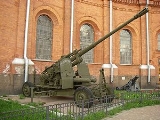
100 mm air defense gun KS-19
Encyclopedia
100 mm air defense gun KS-19 was a Soviet anti-aircraft gun. Following the end of the Second World War the Soviet Union introduced into service the 100 mm KS-19 and 130 mm KS-30
.
The KS-19 is a heavy towed anti aircraft gun that has largely disappeared from front line arsenals due to increased use of more effective surface-to-air missiles. Being a towed weapon an external form of mobility was required, usually an AT-S Medium or AT-T Heavy tracked artillery tractor. The 15 man crew were carried on the tractor along with ready use ammunition for the gun1. Ammunition was loaded as a single round into the loading tray and a well trained crew could fire 15 rounds maximum per minute1.
Anti Aircraft ammunition includes high explosive, high explosive fragmentation and fragmentation types. The KS-19's onboard sights can be used to engage air targets, however increased accuracy was achieved if used in conjunction with a fire control radar such as the SON 9 (NATO Reporting name 'Fire Can')and PUAZO-6/19 director1.
As the KS-19 is a heavy calibre Anti-Aircraft gun it also has some utility in the ground role especially against armored targets. As a result of this two armor piecing rounds were produced: the AP-T (Armour Piercing-Tracer) and APC-T (Armour Piercing Capped-Tracer) with the AP-T round reportedly able to penetrate 185 mm of armor at 1000m1.
The KS-19 was used in action by communist forces in both Korea and Vietnam.
KS-30
The Soviet 130mm anti-aircraft gun KS-30 appeared in the early 1950s, closely resembling the German wartime 12.8 cm FlaK 40 antiaircraft gun. The KS-30 was used for the home defense forces of the USSR and some other Warsaw Pact countries...
.
The KS-19 is a heavy towed anti aircraft gun that has largely disappeared from front line arsenals due to increased use of more effective surface-to-air missiles. Being a towed weapon an external form of mobility was required, usually an AT-S Medium or AT-T Heavy tracked artillery tractor. The 15 man crew were carried on the tractor along with ready use ammunition for the gun1. Ammunition was loaded as a single round into the loading tray and a well trained crew could fire 15 rounds maximum per minute1.
Anti Aircraft ammunition includes high explosive, high explosive fragmentation and fragmentation types. The KS-19's onboard sights can be used to engage air targets, however increased accuracy was achieved if used in conjunction with a fire control radar such as the SON 9 (NATO Reporting name 'Fire Can')and PUAZO-6/19 director1.
As the KS-19 is a heavy calibre Anti-Aircraft gun it also has some utility in the ground role especially against armored targets. As a result of this two armor piecing rounds were produced: the AP-T (Armour Piercing-Tracer) and APC-T (Armour Piercing Capped-Tracer) with the AP-T round reportedly able to penetrate 185 mm of armor at 1000m1.
The KS-19 was used in action by communist forces in both Korea and Vietnam.

